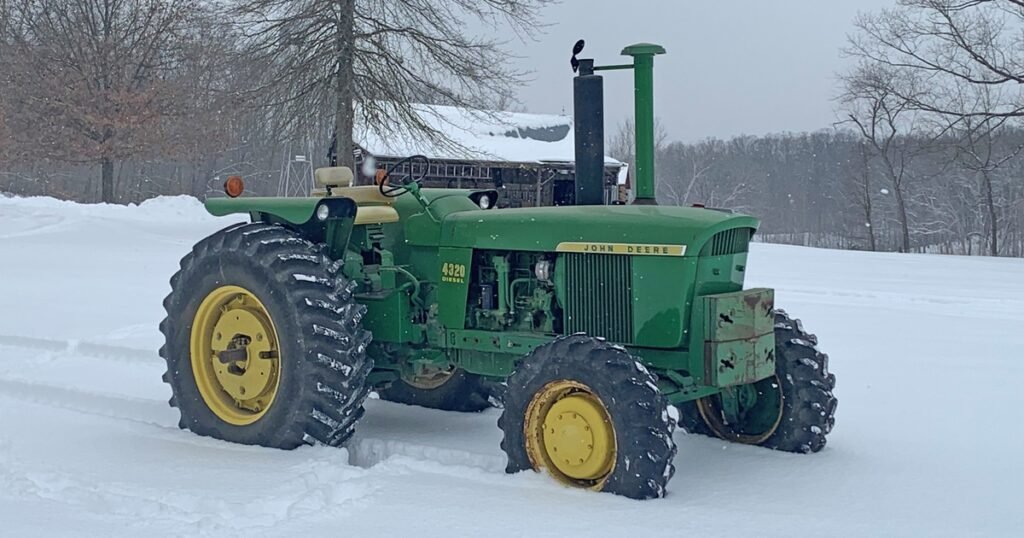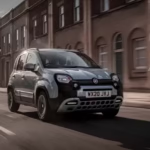John Deere 4320 Review
Pros
- + Straightforward to maintain and repair
- + Excellent resale value among vintage models
- + Robust 6.6L 6-cylinder diesel engine
- + Powerful performance for its class
- + Compatible with a variety of implements
- + Great visibility and ease of use
Cons
- – No factory cab option
- – Lacks modern electronics and ergonomics

Produced for just two years (1971–72), it was Deere’s boldest statement in the horsepower race of the early ’70s—an answer to farmers who wanted more grunt without jumping into four-wheel drive territory. With 116 horses at the PTO and a factory turbo strapped to the classic 404 engine, the 4320 wasn’t just a 4020 with a power bump—it was an evolution.
No cab, no emissions gear, and nothing you didn’t need. Just diesel, steel, and raw, analog work ethic. Even now, it’s one of the most desirable pre-Sound-Gard tractors Deere ever built.
What’s New for This Generation?
Everything and nothing. The 4320 was a one-and-done model, built on the bones of the beloved 4020 but with major upgrades under the hood.
This was the first time John Deere put a turbocharger on a row-crop tractor straight from the factory. That meant more horsepower, more torque, and a whole lot more capability—without changing the tractor’s familiar layout or adding complexity.
The 4320 also got a beefed-up rear end and better cooling to match the added output. But beyond that, Deere kept things simple. No frills, no gimmicks. Just a brutally effective farm tool.
Pricing and Which One to Buy
Back in 1972, you could pick up a new 4320 for around $11,000. Today? A clean example with original sheet metal and the factory turbo will run you $25,000–$40,000—and sometimes more if it’s been restored or has low hours.
This is a collector’s dream and a workhorse all in one. They’re not making more of them, and demand hasn’t dropped one bit.
Recommended Setup:
- Factory turbocharged model (not an aftermarket add-on)
- Syncro-Range transmission for simplicity and longevity
- Dual rear wheels if you’re pulling heavy ground tools
- ROPS and sunshade if you’re planning to run it all day
Engine, Transmission, and Performance
Under the hood is Deere’s proven 404-cubic-inch inline-six diesel—turbocharged and tuned to crank out 116 PTO horsepower. That’s 20 more than a 4020, and it shows. This engine isn’t just strong—it’s got a torque curve flatter than a Kansas wheat field.
The turbo spools smoothly, and the engine never feels out of breath, even when pulling heavy tillage or running big PTO equipment.
Transmission choices were simple but solid:
- Syncro-Range: 8 forward, 2 reverse, manually shifted with mechanical linkage. Dead simple. Rock solid.
There was no Power Shift option on the 4320. But for most jobs, Syncro is plenty—and easier to service long-term.
Top speed is about 18 mph. Acceleration? Steady and composed. It’s not fast, but it pulls like it means it.
Fuel Economy and Real-World Use

The 4320 is about efficiency the old-fashioned way: no computers, no emissions systems, no DEF. Just a big turbo diesel breathing hard through steel fuel lines.
Expect 5–7 gallons per hour under field load, slightly less for light work. Its 35-gallon tank will get you through a full day without needing a refill—unless you’re pulling a chisel plow in heavy soil.
In practice, it handles just about anything:
- 5- or 6-bottom plow
- 12-row planter
- Round baler
- Grain cart
- Loader (with some added front weight)
It’s still a viable machine for small and mid-size farms today.
Interior, Comfort, and Operator Experience
There’s no cab—just an open-air station, steel floorboards, and the hum of diesel in your ears.
But for its time? It’s incredibly usable. Controls are placed with Deere’s signature logic, and everything you need is within reach. Visibility is excellent in every direction. The seat isn’t luxurious, but it does the job.
Add a ROPS canopy and it becomes a pretty comfortable place to spend 10 hours.
There’s no insulation, no HVAC, and no cupholders. But when you’re in the seat, it’s all business—and that’s exactly how it should be.
Infotainment and Connectivity
You won’t find Bluetooth, screens, or diagnostic ports. What you get is a steel dash with:
- Analog tachometer
- Oil pressure gauge
- Coolant temp
- Ammeter
That’s it. No distractions. No warnings that disappear after three seconds. And best of all, no updates required. If something breaks, you fix it. No tech support line needed.
Safety and Ease of Use

There’s nothing automatic here, but it’s solid and predictable.
What you get:
- Optional ROPS bar (get one if it doesn’t have it)
- Hydraulic drum brakes
- Straightforward steering
- Plenty of weight and traction
The controls are mechanical and positive—levers click, pedals feel firm, and the clutch engages like a handshake. You always know what the machine is doing.
For experienced operators, it’s second nature. For new drivers? There’s a learning curve—but it teaches you to pay attention, and that’s not a bad thing.
Maintenance and Reliability
If reliability had a sound, it’d be a 4320 idling at 900 RPM.
Everything on this tractor is built to last and easy to work on. The 404 engine is known for running 10,000+ hours with basic maintenance. Fuel filters, oil changes, valve adjustments—they’re all simple and accessible.
The Synchro-Range transmission is nearly indestructible if you don’t abuse it. Rear ends are strong enough to handle duals and heavy loads. Hydraulics are responsive and easy to service.
Parts? Still available. And thanks to the 4020 parts interchangeability, it’s one of the easiest vintage Deeres to keep running.
Verdict
The John Deere 4320 didn’t stick around long, but it made its mark. It was the most powerful two-wheel-drive row-crop Deere had ever built up to that point, and it did it without compromising on simplicity or serviceability.
No cab. No fluff. Just turbocharged torque and clean, mechanical engineering that’s stood the test of time.
It’s not as common as the 4020. It’s not as flashy as the 4440. But the 4320 occupies a sweet spot in Deere history: serious power in a classic, analog package. And for farmers who want real muscle with no nonsense, it doesn’t get much better.
Still pulling. Still relevant. Still worth every penny.
Specifications
General Information | |
| Manufacturer | John Deere |
| Model Name | 4320 |
| Vehicle Type | Agricultural Tractor |
| Body Style | Row-Crop Tractor |
| Production Years | 1971–1972 |
| Manufacturing Location | Waterloo, Iowa, USA |
| Original Price (1972) | ~$10,345 USD |
Power and Performance | |
| Engine Type | John Deere 6.6L 6-cyl turbocharged diesel |
| Engine Displacement | 6.6 litres (404 ci) |
| Horsepower (PTO) | 115 hp (85.8 kW) |
| Horsepower (Drawbar) | 97 hp (72.3 kW) |
| Rated Engine Speed | 2200 rpm |
| Torque | Approx. 392 Nm (289 ft-lbs) |
| Fuel Type | Diesel |
| Fuel Capacity | 128.7 litres (34 US gal) |
Transmission and Drivetrain | |
| Transmission | Synchro-Range |
| Gears | 8 Forward / 2 Reverse |
| Drive Type | 2WD (standard) |
| Clutch | Dry disc |
Hydraulics and PTO | |
| Hydraulic System | Closed center |
| Pump Flow | 22.7 gpm (86 lpm) |
| Rear PTO | 1000 rpm |
| Rear Hitch | Category II |
| Lift Capacity | Approx. 2,722 kg (6,000 lbs) |
Dimensions and Weight | |
| Length | 3,810 mm (150 in) |
| Width | 2,440 mm (96 in) |
| Height (steering wheel) | 2,150 mm (84.6 in) |
| Wheelbase | 2,540 mm (100 in) |
| Weight (Shipping) | 4,264 kg (9,400 lbs) |
| Weight (Operating) | 4,627 kg (10,200 lbs) |
| Ground Clearance | 420 mm (16.5 in) |
Notable Features | |
| Cab | Open station (canopy optional) |
| Brakes | Hydraulic wet disc |
| Steering | Power steering |
| Lighting | Basic incandescent work lights |
| Instrumentation | Analog gauges with tachometer, hour meter, and fuel level |
Variants | |
| John Deere 4320 (Standard) | 2WD, Synchro-Range transmission |
Available Paint colour/Colours |
| Classic John Deere Green with Yellow Wheels |





